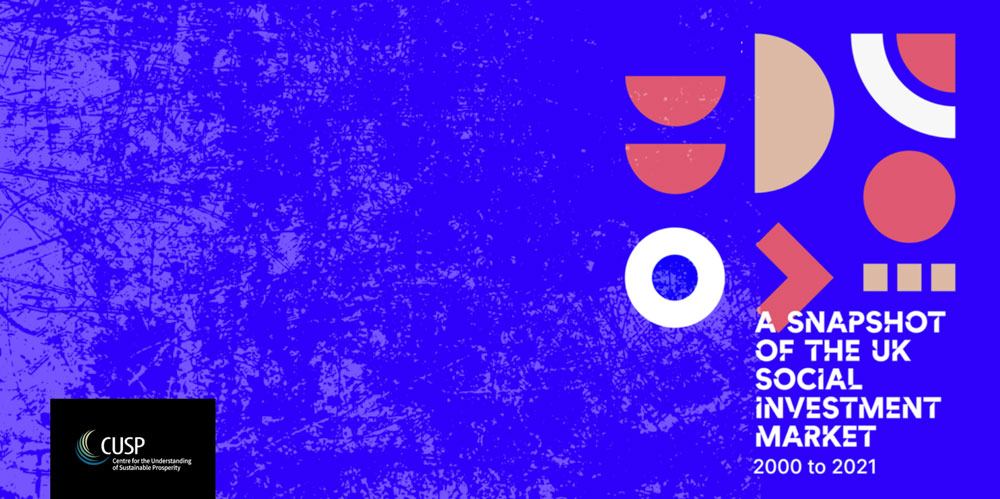A Snapshot of the UK Social Investment Market
Interest in the social and environmental ‘purpose of business’ is growing. Could it be part of a move towards a better kind of economy and what kind of investment is needed? CUSP Fellow Dr Jess Daggers points to the history of the social investment market in the UK as a source of insight into the attempt to combine financial tools and social purpose. This blog summarises her recent report A Snapshot of the UK Social Investment Market 2000 – 2021, co-authored with Flip Finance colleagues David Floyd and Dan Gregory.
Blog by Jess Daggers

In February 2020 I was invited to become a commissioner on the Adebowale Commission on Social Investment, an initiative created by Social Enterprise UK, and lead by SEUK’s Chair, Lord Victor Adebowale. Social investment is a form of financial investment, made into organisations that generate both social and financial returns. After decades of policy initiatives aimed at building a market for social investment, the Commission set out to ask: has access to finance for social enterprises actually improved? Does the market work as it should?
As the work of the Commission got off the ground, it struck me that a huge amount has happened over the past 20 years, and that a concise summary and analysis of this history would help to inform discussions about what should come next. Adding to the knowledge I had acquired during my PhD studies, I joined forces with two other longstanding participants in and commentators on social investment, and the Snapshot report is the result. It is our attempt to organise and make sense of what has been a busy, energetic and often controversial field of activity.
The Snapshot seeks to highlight not just the breadth of activity, but the way these activities were framed by policymakers. From 2010 onwards, this framing used the idea of a market, which would bring together the supply side (a new breed of investors who want to combine financial return with positive social impact) with the demand side (the UK’s thriving social enterprise sector). Hundreds of millions of pounds of public money have been devoted to bringing this idea to fruition.
The wide range of activities that took place in the name of the social investment can be organised into four ‘ingredients’:
- Attracting new investors into the market
- Developing a wider range of investment products
- Embedding impact measurement as standard practice across the market
- Transforming the social sector’s ability to take on investment capital
These four ingredients amounted to an overhaul of the funding landscape for social sector organisations, including social enterprises. A huge amount of energy was poured into testing how the tools and techniques of finance could be introduced, and what kinds of investment could be made to work. The last of these ‘ingredients’ was particularly controversial, as the new gatekeepers of the new supply of social investment capital sought to mould social sector organisations into ‘investible’ propositions.
Looking across the sector in 2021, a lot has changed. There are now opportunities for finance that did not exist before. But there have been consistent criticisms that some of the biggest financial institutions in the social investment market – in particular, the flagship Government initiative, Big Society Capital – have not done enough to recognise the realities of social sector organisations, instead prioritising return requirements and low-risk opportunities. These tensions have wider significance for global attempts to direct finance towards positive social and environmental impact. How far should ‘social’ organisations be treated differently, and given different terms? How far should investors be expected to adjust their practices and return expectations? How far can profit and purpose really be combined?
As the Adebowale Commission prepares to make its recommendations, the Snapshot sets out five sets of questions that still need answering:
What terms should social investment be made available?
This question has been an ongoing source of tension: should investees have to conform to the standards set by investors? Or should investors adjust their expectations and assessments in light of the ‘social’ status of social sector organisations?
Staying niche or going mainstream?
Social investment continues to suffer from a kind of identity crisis: should this market be made up of specialist providers reaching organisations that cannot be reached by mainstream investors? Or should the aim be to bridge the gap with the mainstream providers, potentially achieving greater reach overall?
What should the role of government be?
What is government’s future role in social investment? Previous governments have played significant roles in shaping activity and institutions, the narrative and vision. Should future governments take such an active role?
What should be expected from Big Society Capital (BSC)?
BSC is the biggest and most influential institution in the social investment market. It was set up under a number of legal and regulatory constraints that significantly curtail what it can do in the market. It has been the target of intense criticism from the outset. Given this legacy, what should be expected of BSC, and what would need to happen to make change possible?
Who benefits from social investment?
In theory, the market is open to anybody who wants to take part, and deals are struck that benefit both parties. In reality, some groups are more successful at accessing investment, with clear divisions according to characteristics such as ethnicity or geographic location. There are also concerns that some deals disproportionately benefit investors. These concerns prompt questions over who social investment is supposed to be for, and whether enough is being done to realise those intentions.
Full report
The report is available in open access format via the flipfinance.org website.



